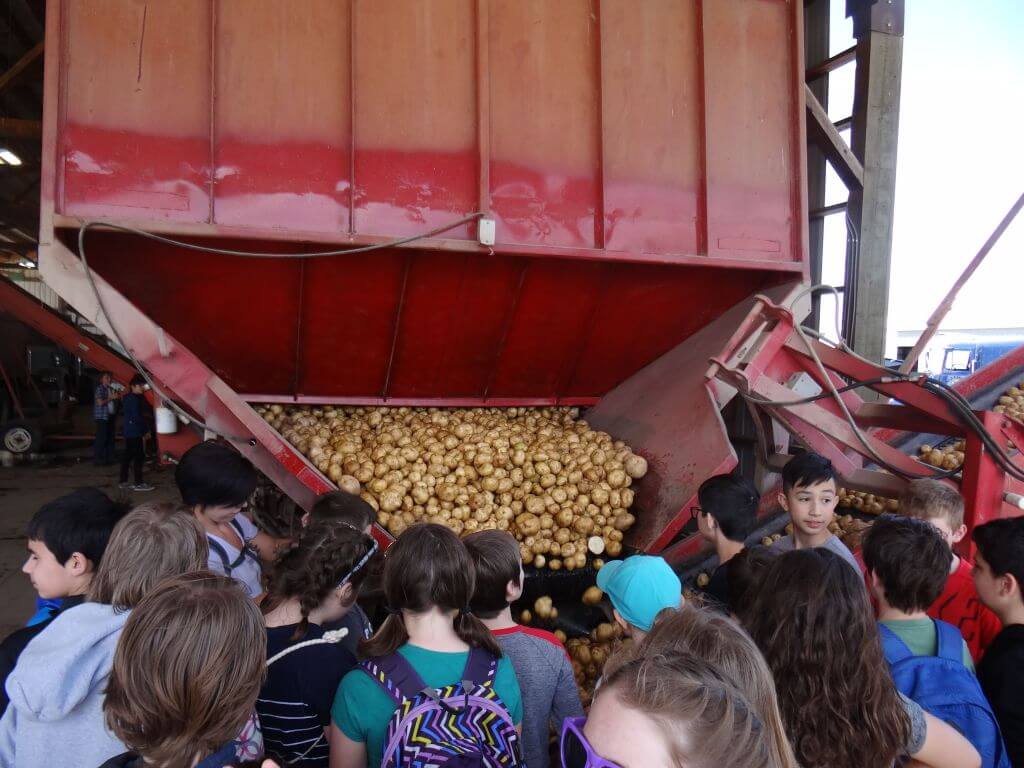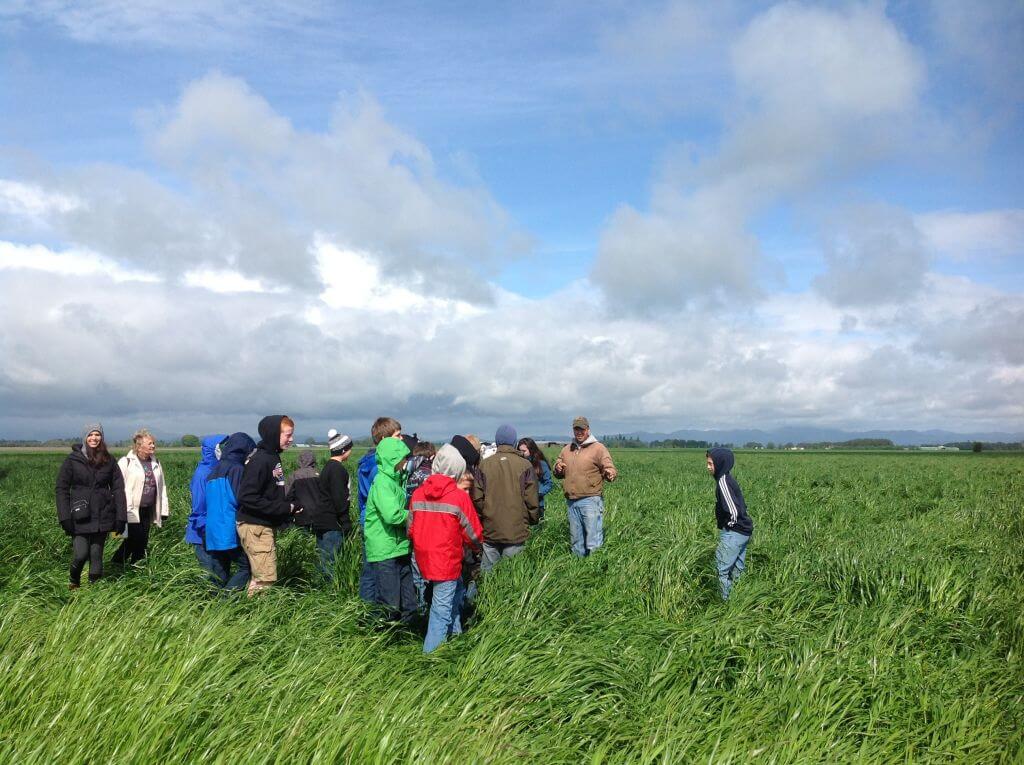Interview: Mallory Phelan of Oregon AgLink
 SEDCOR: What is Oregon Aglink?
SEDCOR: What is Oregon Aglink?
Mallory Phelan: Aglink is a membership organization that was founded in 1966. When we started 55 years ago, growers all over the state noticed there was a lack of awareness of Oregon ag. There was a major disconnect between the people growing food and the people consuming the food. The urban-rural divide, as it is now usually called. And that divide is still present. So, we were founded to try and bridge that gap.
We run a few different programs around education. One of the most popular is our Adopt-A-Farmer program.
Adopt-A-Farmer is a no-cost program for middle-school students anywhere in the State of the Oregon and for students of nearly any subject. The class could be art, science, economics, whatever the subject might be, we help bring it to life through agriculture. We fund field trips for classes to go visit farms or ranches all over Oregon. Then, we place that same farmer into the classroom a couple of times throughout the year and help bring concepts they are reading about to life.
SEDCOR: Even beyond the students you serve, what do most people not understand about the Oregon grower on a personal level? Who is the Oregon farmer, as a person?
Phelan: I believe many people think of growers as a homogenous group, a monolith. People imagine everyone in ag as being the same age, the same gender, the same everything. In reality, growers are far from monolithic in these areas, and especially in the way they think, act, and vote.
I also think people are always surprised to learn just how educated growers are. Many of those we work with have highly specialized advanced degrees in science, economics, and other related fields. So, there is the formal education they have and the knowledge they learn in school, but there is also a vast amount of generational knowledge being passed down. And that could mean the practices and instincts they learned from a parent or grandparent. But, in many cases, it is the knowledge they take and share amongst themselves.
Right now, the average age of a farmer is closing in on 60. That number is thrown around a lot, usually in a very nervous, frightened tone. What we don’t hear about is the younger generation of growers and the amazing things they are doing to innovative. Some are stepping into farming from the outside and do not have family knowledge to pull from, but they are collecting mentors and knowledge is being shared and improved upon that way.

SEDCOR: Most of us don’t ask too many questions about the food we buy at the grocery store. We figure someone grew and harvested it, but not much more than that. What would people be surprised to know about when it comes to art of farming?
Phelan: Oh my gosh, there are so many moving pieces. It is definitely not as simple as dropping a seed in the ground and, boom, a few months later you have a plant to pull up and a product to sell. There is almost nothing about farming that can be siloed off. It is highly impacted and dependent on things outside of their control. Markets, weather, regulations, consumer preference.
SEDCOR: I think when many people picture ag, they imagine the large, factory-style farming happening in the Midwest. They think of soy, corn, and wheat. They picture million-dollar combines spewing diesel and carbon. What’s different about how we farm here?
Phelan: We can grow so many crops here. And while we don’t have tropical crops like citrus and avocados, we are still an extremely diverse growing region. Even each farm tends to be very diversified. They try to not put all of their eggs in one basket and work hard to find just the right balance.
Growers have to think very far ahead. Yes, they are looking at what to grow this year or next year, but they are also thinking generationally. They may want to plant more permanent crops like hazelnuts or fruit trees. Those crops take a lot more labor and investment upfront, but they can produce for much longer. They are also thinking about rotational crops and doing what it takes to keep their soil healthy for the long haul. We just have so many options in the Valley. In fact, a lot can grow on the East side of the state as well.
Oregon is a specialty-crop state. We grow more than 220 different crops, which is one of the highest in the nation.
SEDCOR: Does that diversity make processing more complicated?
Phelan: Oregon has quite a few co-ops that have formed to help get some common crops to market. But since we grow so many things, there is just more to consider than with the commodity crops grown in other parts of the country. How you do transport of out the farm? Are you taking everything to the Port of Portland? Is it going down the Columbia? Is it going on rail? This can cause bottlenecks in shipping and processing.
Investments are being made in processing capacity around the state, but we definitely have shortages and gaps. Meat processing, for instance, experiences these bottlenecks in a very major way. Hemp is another example of a crop people were excited about, and one that many people grew, but in many ways fell flat because the processing infrastructure just wasn’t there.
Some farms are trying their hand at becoming vertically integrated. To do this—and to do almost any harvesting and processing—farms have to get very creative with their equipment. Again, because we have so many crops and each has its own character and needs, there is a need for highly specialized equipment. Most of the major manufacturers of farm equipment are developing and producing their equipment for the giant commodity farmers; that’s where the money is.
Farmers in Oregon are very innovative. They will personally modify their equipment to fit their particular needs. There are some very cool companies building equipment specifically for specialty crops. It takes a very sophisticated engineering mind to build out these solutions.

SEDCOR: How do you imagine the future of ag in Oregon? What makes you excited?
Phelan: The most obvious change will be the adoption of technology by growers. Almost all parts of the process will be more mechanized and more automated. Self-driving technology will make its way into farm equipment. I think some of the most exciting innovations will come in field management. For instance, I was reading about a drone being developed that can fly above a field to identify and exterminate moles in a grass seed field.
Right now, a lot of this tech adoption is coming out of necessity. Labor shortages are a major pressure pushing growers to consider bigger investments in these kinds of technologies. Those of us in ag have been talking about tech adoption for a long time, but this moment feels different.
Another trend I see continuing is the creation of smaller, niche markets. Younger generations are finding interesting ways to make money in food production and are finding markets for their products. For instance, there is company that sells pork finished with Oregon hazelnuts. Oregon does not do much in pork, but we certainly grow a lot of hazelnuts. Obviously, Hazelnut Finished Pork is a very specific product with a very specific market, but they are making it work.
Even with those small, niche markets, economies of scale will still need to exist to feed more people. To return to the first question, I think people do not understand how much food a relatively small farm can produce. It is not until people see truckloads of green beans, cauliflower, onions, and other specialty crops that they understand how insanely efficient the family-owned industrial farm is and they understand how incredible it is to always have shelves stocked with delicious local food.
SEDCOR: What can people do to familiarize with themselves farms and farmers?
Phelan: Obviously, you can shake hands with your small farmer at the summer market, but many larger, industrial farmers are also very interested in connecting with their customers. I know many who are more than happy to answer questions and help people understand how the ag industry actually works. They love what they do and are happy to share it with as many people as they can.
Learn more about Oregon Aglink by visiting aglink.org
